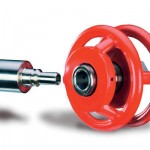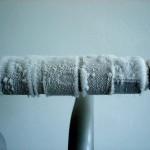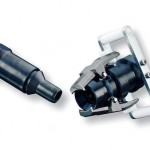Many processes in the chemical industry take place at extreme temperatures, with demanding requirements for all components. Not only is it necessary to ensure a fast and smooth production flow, but also to guarantee the required operating safety. Quick coupling systems from the German company Walther-Präzision fulfil these requirements. The diversity of the types developed is almost unlimited. When separating and connecting pipes, hoses or other conduit systems, it has to be ensured that gases and fluids cannot escape uncontrolled.
Quick coupling systems have proven their worth wherever fluids, vapours or gases need to be transferred quickly and safely. Aggressive, toxic or highly explosive substances are frequently used in the chemical industry. Here, even small amounts of leakage pose a threat to human health and to the environment. When separating and connecting pipes, hoses or other conduit systems, it has to be ensured that gases and fluids cannot escape uncontrolled. The technical challenge is to keep the valves on both coupling halves closed until the latter have been sealed to the outside during the connection process. Only then may the valves open.
At the same time, many processes take place at extreme temperatures. In order to further accelerate production, process temperatures in the chemical industry have been pushed up over the years. One example is the increased use of heat transfer oils in systems and reactors operated at temperatures of more than +300 ºC. Even temperatures between -40 ºC and approximately +200 ºC make considerable demands on the material and sealing ability of the components used. By today’s technological standards, every qualified manufacturer of components should be able to master this temperature range.
The engineering challenges increase dramatically if we consider temperatures between -50 ºC and +250 ºC. Special systems with carefully selected seal materials are required here, for example polytetrafluoroethylene (PTFE). These materials offer temperature stability combined with very high chemical resistance. The TE series, explicitly developed for this temperature range, has been tried and tested in a wide variety of applications in the chemical and process industries. Extreme temperatures call for unusual technical solutions: some of the couplings in the TE series, for instance, are equipped with ring grips for safe and ergonomic operation. It is impor-tant for the user that thermal bridges to these grips are minimised. The ring grips are therefore attached to the locking sleeve and the housing by means of special stud screws.
In addition, the TE series is well-suited for use in the threshold temperature region of conventional elastomer sealing systems and successfully employed, amongst other things, in chemical element production at temperatures of about +210 ºC.
If superheated steam lines have to be connected safely, more and more safety-related aspects come into play. The German stand-ard DIN 2825, for example, stipulates the use of couplings with elastomer sealing on both sides to prevent the leakage of hot fluids and gases while connecting or disconnecting steam hoses. It is vital for the safety of the operators involved to completely avoid any squirting during this connecting action. The sealing technology of the TE coupling was specially designed for this application. At the same time, sealing is required on both sides, so that any condensation due to cooling cannot produce a vacuum in the hose. Blistering could otherwise easily occur, leading to malfunctioning hoses (popcorn effect). Only accurately designed valve springs, which allow the valves to open at a defined degree of vacuum, can prevent this kind of hose damage. Since steam pipes or tubes are mostly made of stainless steel, the cou-plings are manufactured from the same material.
The demands on the sealing technology are increase still further with chemical processes in the high-temperature range from +250 ºC to +450 ºC. The required steel and all additional elements need to be designed for maximum heat resistance. The coupling systems developed for this purpose are commonly encountered, for example, in the petrochemical industry. The non-resilient seals employed there are absolutely gas-tight, not only in high-pressure couplers but also in low-pressure types. The stipulated safety is guaranteed, even after repeated connection.
Heat transfer oil: an example
To maximise the energy supply, many systems use heat transfer oils at temperatures of up to +310 °C. Conventional, hydraulic plug-in couplings lead to substantial seal problems at these high temperatures. The locking mechanism, for instance, could become blocked by sticky residues of cracked oil or swollen seals jamming the coupling systems. The result: the seals no longer work properly during disconnection because the valves remain open and oil can escape uncontrollably.
At the same time, safety standards are increasing. Users must be protected from scalding oil. When developing the cou-plings used for heat transfer oils (11 series with 12 and 19 mm bore sizes), the designers attached special importance to an automatically engaging locking mechanism and a robust, easy-to-release, double-sided catch lock with heat-insulated hand grips made of creep-resistant plastics. Smooth surfaces additionally reduce the cleaning effort.
Ice age in the gas tank
At the other temperature extreme – very low temperatures down to -253 ºC – the freezing cold causes the materials and seals to become brittle. Generally speaking, elastomers are no longer suitable here and an alternative seal technology is called for: a seal concept based either on polymers or on metal represents one possible solution. Polymer seals are sometimes chosen at process temperatures down to -196 °C. Metal is used as a seal material for temperatures between -196 °C and -253 °C.
The typical low-temperature applications in the chemical industry include the transport or storage of different high-pressure gases as well as fluids in the low-pressure range. Vacuum super-insulated containers are used at low temperatures, for instance, to transport and store nitrogen, helium, oxygen and hydrogen.
The transport of liquid nitrogen from a storage tank through a hose to a sample storage container at a temperature of -196 ºC constitutes a particular challenge. The pressure in this application ranges between 1.5 bar and 3 bar. When the filling process is complete, the frozen coupling thaws due to the surrounding air and can then be separated again.
These interfaces used to be connected with a time-consuming screw solution. However, users demanded that the liquid nitrogen storage container be changed in the shortest possible time without compromising the level of safety.
A quick coupling by Walther-Präzision made its debut during a two-month trial phase. Users were asked to test the gas-tightness and, in particular, the temperature resistance of the new coupling system. The system passed all these tests with flying colours. Time and cost savings as well as added flexibility through faster changes were the outcome.
Future technology for everyday use
In many other processes in the low-temperature range the couplings do not freeze. The storage of hydrogen in liquid form is one application with future prospects. Intermediate storage solutions are necessary to provide hydrogen as a combustible gas not only for future fuel cells but also as a basic product for a variety of industrial applications. When cooled to -253 ºC, liquid hydrogen occupies only one fifth of the volume required in the gaseous state. Reliable, vacuum-insulated storage is crucial here.
Suitability for daily use, robustness and reliability are also imperative for hydrogen fuelling. The vacuum-insulated fuelling systems from Walther-Präzision, which are used amongst other things for Linde AG’s hydrogen tanks, feature metallic seals. The entire connection process is monitored by sensors, ensuring adequate protection for human health and the environment during the connection, fuelling and disconnection processes. A further advantage is that, thanks to the vacuum-insulated fluid line, the system inside the coupling cannot freeze.
Online-Info www.cpp-net.com/2309402
Share:









